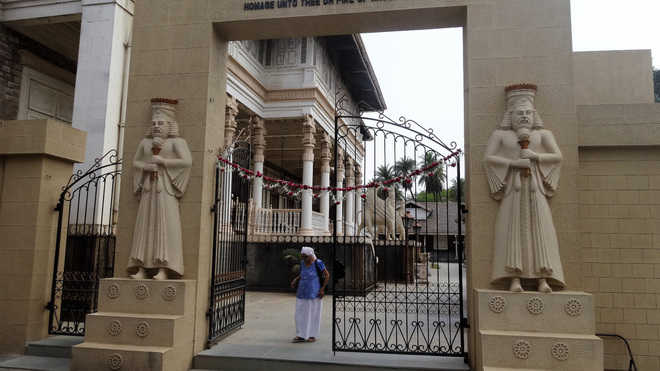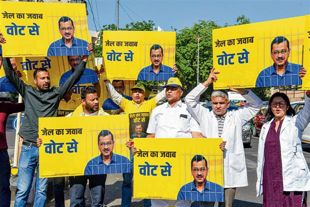
Faith accompli: A Parsi woman comes out of the fire temple
Kavita Kanan Chandra
Udvada is a pretty small heritage town with lanes and bylanes lined with traditional Parsi row houses, made of teakwood and bricks. The laidback coastal town in Gujarat houses the holiest fire of the Parsis that is supposed to be burning for almost 1,296 years now. The ethnic group from Persia (Iran) first landed in Sanjan nearly 1,300 years ago. They were granted asylum by the noble King Jadi Rana. Within a few years, they consecrated the Holy Fire and built a fire temple. However, their fight for survival and protecting their religion is a constant saga of their history. Intermittent threats from Islamic invaders made them move from one place to another till with the help of the rulers Durjansinghji, the Gaekwads and the Peshwas, the Holy Fire found its destination at Udvada.
The once-thriving town now appears to be desolate since most of the Parsis have migrated to Mumbai or abroad. The otla (porches) of the century-old houses have become a place to laze around by the aging owners. The crumbling houses and locked doors might disappoint but an aura of antiquity envelopes them. If you care to pause and ponder, each house appears to tell a tale of its glorious past and a way of life interwoven with the faith of its residents. Each house has a symbol or pictures of Zoroastrianism. The Holy Fire, the picture of Prophet Zarathushtra, who propagated the teachings of one supreme God, Ahura Mazda, and the symbol of Iranshah with two wings are on the walls and inside the Parsi homes. Water holds sanctity and each house has a well since all religious ceremonies require fresh water.
As you walk down the paved roads admiring the architecture, the intricate designs on wrought-iron railings and creaking gates on every porch of a Parsi home, you might just discover the fire temple bathed in white emerging from a street full of residential houses. It appears to be camouflaged. Perhaps it is to protect it from an attack way back in the 18th century. The Iranshah Atash Behram (fire temple) houses the Holy Fire that was enthroned here in 1742. Zoroastrians from all over the worldcome here to pay homage to fire. “Homage unto Thee Oh Fire of Ahura Mazda” written on the gate of the temple extol the virtue of fire or light, which is so integral to Zoroastrianism.
The month of May, Adar Mahino, is dedicated to fire. The pilgrims buy small logs of wood and sticks of sandalwood to pay homage to the burning fire. The men wear typical Parsi caps called sola topis and the women cover their heads with scarves.
Non-Parsis are not allowed inside the temple but the state Government Zoroastrian Information Centre, which is housed in a restored bungalow set in sylvan surroundings, is a great place to acquaint yourself with this ancient religion.
Various rooms are assigned to the aspect of history of Parsis, culture, religion, renowned Indian Parsi personalities and detail about typical customs like navjote ceremony (initiation of young Parsi into religion), wedding and disposal of the dead in dakhma (Tower of Silence) where it is naturally decomposed by vultures. You are also enlightened by the teachings of Zoroastrianism.
The three principal codes of conduct followed by Parsis are humata, hukhta and huvarshta that is good thought, good word and good deed. The religion could be a revelation for many. One is saddened to know that this minuscule community is sadly dwindling. However, after loading yourself with all the knowledge, don’t forget to load yourself with bottles of Sunta raspberry soda from the cafeteria, a speciality drink unique to Udvada. Udvada is also a haven for Parsi cuisine lovers.
Even the Atash Behram premises have much activities among local vendors. Local women hang around selling sarias (sago wafers) spiked with herbs and spices. Some lay their stuff on roadsides like lemon grass and fresh mint leaves. Parsi love their lili chai (green tea) infused with these flavours. The Bharat bakery handcart lured visitors with its nankhatais, khari, butter biscuits, and even dried fried bits of fish packed in tiny plastic pouches. According to third generation owner Nilesh, Parsis love fish, and if Udvada is a holy place for prayers, it is also a perfect place for feasting on Parsi cuisines.
With many Parsi dharamshalas, restaurants and dhabas offering delicacies like egg bhurji (scrambles eggs), dhansak, sali par eedu (fried eggs over potato slices), fried boi (white mullet fish), surmai fish curry, chicken pakora, homemade ice-creams andcusturd among other scrumptious dishes; even non-Parsis would have a good time. Strolling in the streets in the morning you could have doodh na puff (a glass of milk froth) from local women moving with glasses on tray, then head for the rocky beach to relax sitting on a rocky perch and amble around large weathered bungalows to build an appetite to go for a big hearty Parsi meal.
Fact File
getting there:
Nearest airport: Surat. One can also drive from Mumbai and Vadodara
(both have airports).
Nearest railway station: Udvada Railway station.
moving around: Udvada is a small town so you can walk around or hire a rickshaw.
where to eat: Ahura (it is on Mumbai Surat NH8 at Amboli), Globe Hotel serves generous portions of Parsi food, Ashishvangh Hotel, Dastoor Baug Dharamshala are known for their homemade ice-creams and meals, Parsi da dhaba (at NH8). There is Irani bakery and Bharat bakery hand cart for nankhatais and biscuits. You could purchase dhansak masala, chutneys and pickles from veranda shops near Atash Behram.
Methiya nu achaar (spicy raw mango pickle), Libu nu achaar (tangy, fresh lime pickle) and keri ni chutney (sweet-spicy mango pickle) are Parsi specialities.
Shop for sandalwood sticks that range from Rs 50-Rs 1000 and all are pure.
Some dos and don’ts: Non-Parsis are not allowed to enter the fire temple, so respect their religious custom. Dress modestly and maintain the sanctity of the holy town.
Thus goes the folklore
The Parsis had braved a terrible storm and had promised to build Atash Behram (fire temple) if they landed safely. They sought asylum from King Jadi Rana. The king sent a bowl full of milk to the brim signifying there’s no place for immigrants in his kingdom. The wise Dustur added sugar to the milk with a promise of never being disruptive and indicating they would blend in just as sugar adds sweetness to milk. Parsis never went back on their promise.



























